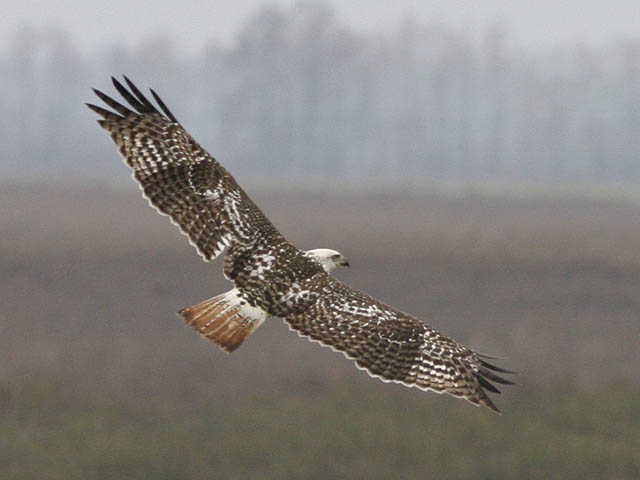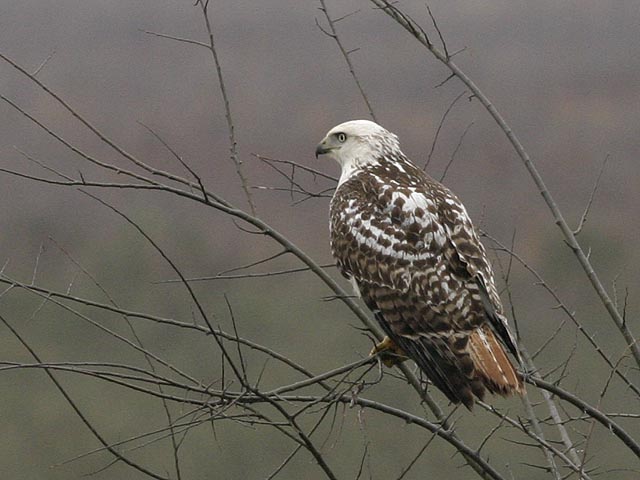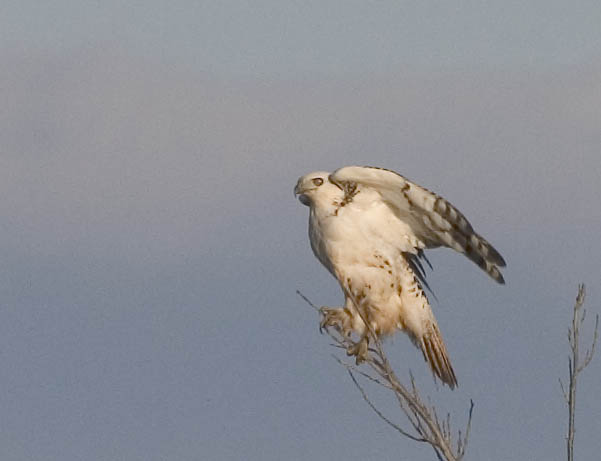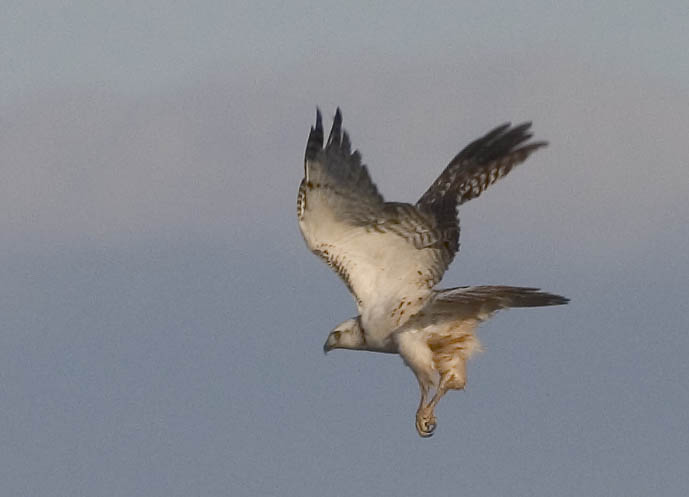|

KRIDER'S RED-TAILED HAWK?
(Apparently its a Harlan's. See
Updates Below)

During December, '04, and January.
'05, I saw white-headed hawk in the same location several times. I was
fairly certain that this was a Red Tail Hawk but with very interesting
coloration and I wanted to get a photo. So, on February 6, 2005, on my
way to Shreveport, I pulled over on the shoulder of I-49 and shot some
photos. This photo was taken right after I got just a little too close.
When I got back home that day, I did
some reading and discovered that this was a form of Red-tailed Hawk
known
as "Krider's Red-tailed Hawk." It was formerly believed to be a
separate
sub-species, but is now thought to be a Eastern Red-tailed with a
distinct color "morph."
There were other similar Hawks in the
area with varying amounts of white in the feathers. I will attempt to
obtain additional photos on my next trip through Natchitoches.
The
next photo is the same bird just
before take-off.

UPDATE
I
had the chance to take some more photos on March 3, 2005. Though I
could not get any closer to this bird, the photos below do show body
much better.

In
the photo above, the hawk is just getting enough of me trying to get
closer and is about to take off. In the photo below, the hawk has just
flown.

After some more thought, I have come to a more inconclusive conclusion.
This may not be a Krider's Hawk but may instead simply have some degree
of albinism. If this bird sticks to its favorite perch, I will try to
get even more detailed photos in the future. If you have some insight
as to whether this hawk is a Krider's form, please post the info to the
rec.birds newsgroup.
UPDATE July 21,
2005
I
had the chance to travel this roadway for work last week and did not
see the hawk anywhere. That is not surprising considering that it is
usually much more difficult to spot hawks when the trees are full of
green leaves and this hawk may have migrated north or simply moved to
new hunting grounds. I will pay particular notice to this area after
the leaves have fallen by late November.
UPDATE March 6,
2006
Today I received the following e-mail:
"Hi E. Miller,
What nice photos of the whitish hawk on your web site. It is very
similar to an adult Krider's Hawk, but is subtly different. It is a
light-morph adult Harlan's Hawk. We are working on an article
describing them as a separate species.
Why is it a Harlan's? First, there are some spots on the underparts.
Adult Krider's have unmarked underparts. Next, look at the tail. It has
subtle dark markings on it, a feature of Harlan's but not Kriders.
Krider's have the base of the tail white and no barring. See the
attached jpegs of an adult Krider's. Finally, the patagial mark of
Krider's is rufous, not brown.
Congratulations of such nice pics. I have never seen an adult light
Harlan's with a white head. Great.
Cheers, Bill Clark
P. S. Coauthor of Hawks II raptor field guide."
I
obtained Bill's permission to post the letter. I am certainly no expert
and accept Bill's ID. I have driven back through this area several
times in recent months to no avail. Apparently, this Hawk did not
return to the same small area north of Natchitoches, Louisiana. I have
seen many other light colored Red Tailed Hawks in this area and several
that might have been the Krider's form, but I have not had the chance
to stop and photograph any. Since I usually see between 10-20
Red-Tailed's in a 5 mile stretch between November and March, I should
have many chances to get some more photos.
ANOTHER UPDATE:
In
a separate e-mail, Bill pointed out that the Hawk shown above is
actually a juvenile.
YET ANOTHER
UPDATE: December 5, 2006
Yesterday, I received the following e-mail concerning this Hawk.
Actually, I received two e-mails. Both claimed that this Hawk was not a
juvenile, but the following message from Brandi Quick claims that this
is not a Harlan's. I got Brandi's permission to post her
e-mail.
"Hi. First I would
like to say that
you have some great pictures on your site. Secondly, I just wanted to
let you know that you actually took a picture of a light morph or
possibly a partial albino red-tail, not a Harlan's or Krider's. A
Harlan's hawk is mottled black and white with a white, gray or brown
tail, not a red tail. That bird is way too white to be a Harlan's.
However, a Krider's red-tail will most often have a white tail, but can
sometimes be pink. The tail on that bird is too red to be a Krider's.
Also, this is an adult since red-tails do not get their red tails until
their first molt which is a year after hatch. You will never see a
juvenile bird with a red tail, no matter what subspecies of morph. The
bird is probably a second year bird due to its yellow eyes. But I have
seen "normal" red-tails that had yellow eyes and were 3 years
old.
Here are a couple of references and some sites with pictures for
reference. .
http://www.birds.cornell.edu/AllAboutBirds/BirdGuide/Red-tailed_Hawk.html
The "Harlan's Hawk" was once considered a separate species. It breeds
in Alaska and northwestern Canada, and winters on the southern Great
Plains. This very dark form has a marbled white, brown, and gray tail
instead of a red one. Many individuals intermediate between Harlan's
and more typical Red-tailed Hawks can be found.
http://www.montanaraptor.org/rehabreleasesHRLH7204.htm
This is an excellent site to help distinguish between Dark morph red
tails and Harlan's.
http://www.americanbirding.org/pubs/birding/archives/vol36no5p500to506.pdf
I hope this helps!!!
Brandi Quick
BS Wildlife Ecology and Management"
In response to my e-mail
requesting permission to post her letter, Brandi wrote:
"Hi Eric. I don't mind
if you post
my letter. I don't pretend to be an expert, but I have been taught by
experts and there are just too many facts that dispute that bird is a
Harlan's for sure. It may have Krider's lineage, as many birds ranges
overlap and it could be a Krider's/Eastern cross. But it is without a
doubt NOT a Harlan's and NOT a juvenile.
Here is another website with pictures of a Harlan's and these birds
were identified by very respected bird people who have also written
field guides: http://www.schmoker.org/BirdPics/HRLH.html
I have never heard of Bill Clark, but will ask around about him. He
should know better!!!
Brandi Quick"
Ironically,
Brandi, while not knowing who "Bill Clark" is, has pointed in her
second e-mail to birds idenitified by "very respected bird people who
have also written field guides." The irony in this statement is that
one of the "very respected bird people" who helped in the ID's on that
page was "William Clark." However, the page identified does not
conflict with her statements as far as I can tell.
Because of
the juvenile/adult controversy, I went back and looked for Bill's
letter to make sure that I was quoting him right about the "juvenile"
claims (especially since he calls it an adult in the quoted e-mail) and
to get his e-mail address, but I converted the Outlook data to a CD
archive and can't figure out how to restore it. Microsoft strikes again!
After
receiving a second e-mail about the ID's on this page, I looked up my
web stats to determine from where the recent hits had come and found a
website for an Arkansas Hawking association. There were no Krider's
claims on the board there, but an interesting discussion about the
"juvenile" issue. Additionally, one falconer claims to have seen this
hawk last year in the same location. I haven't been through that area
much in the past year but will have to return to the area to see if I
can get some more photos. If you have any pertinent comments, please
e-mail me at millereric@bellsouth.net.
The apparent choices,
based on comments received to date are: 1) Light Morph Harlan's, 2)
Krider's/Eastern Cross; or 3) Light Morph/Partial Albino Eastern Red
Tail. I'll update this page if the input continues.
UPDATE:
December 6, 2006
After
receiving the above e-mail from Brandi and after some extensive
Googling necessitated by my faulty e-mail backup, I asked Bill for his
input on the more recent comments. Bill forwarded the following.
"Hi Eric,
Thanks for the followup. I do have some input that you can
post on your web site. Please send a copy of my email to
Brandi and the others who emailed you. See below:
I have looked at more than 150 specimens of Harlan's Hawks and more
than 1000 specimens of Red-tailed Hawks and seen many in the
field. I have looked at numerous photos of both
taxa. I now understand better the plumage variation in
both. Some of what is below has never been published.
The hawk in question is definitely a juvenile! Note the
two-toned upperwings. These are only found on juvenile
Harlan's and Red-tailed Hawks; NEVER on adults. Note also the
pale yellow eyes, never found on adults of both taxa (these are pale
brown), and narrow dark subterminal bans on secondaries.
Adults show a wider, blacker subterminal bands on secondaries.
Next, about 10% of pure adult Harlan's show rufous on more than half of
their tails, a few are completely rufous. More than half of
the adults show some rufous in their tails, usually as a band near the
tail tip. Interestingly, a few juvenile Harlan's, such as the
one in question, have adult-like tails. A few juvenile
Red-tails have a rufous wash on their tails, but always with the
juvenile banded pattern.
No adult Red-tail has a tail that looks like the one on this hawk, with
an ill-defined dark subterminal band and irregular banding on some
rectrices. Adult Red-tails almost always show a narrow,
well-defined dark subterminal band, although a few lack this.
Krider's adults have a paler rufous tail, often with whitish base, and
usually with a very narrow dark subterminal band and never with any
other banding.
Harlan's have a light morph, perhaps 10-15% of population, some of
which are just as white as any Krider's Hawk.
No Red-tailed Hawks, other than Krider's and albinos, have all white
heads. Some Harlan's, both juvenile and adult, have white
heads.
The hawk in question is definitely a juvenile Harlan's Hawk.
Please consult plate 26 in Clark and Wheeler Peterson series Hawks,
Plates RT13, 14, 19,21, & 26 in Wheeler & Clark, NA
raptor photo guide, plate 425 in Wheeler's western raptor book, and
RT25 & 26 in Ligiouri's Hawks from every angle for photos
showing much of the above.
Cheers, Bill Clark"
UPDATE:
December 7, 2006
I think the
following highlights the spirited discussion that can come from
identifying subspecies, color morphs, ages and etc. of any bird. After
forwarding the above letter to Brandi, she responded. I forwarded her
response to Bill and he responded. The following are posted for
insight, slightly edited and with photographs removed because I don't
have, and didn't seek, permission to post them.
"I still disagree. I
have consulted
several ornithologists, falconers, and avian vets who all agree that
the bird is definitely NOT a Harlan's. And as for the eyes, I have a
juvenile red-tail in my possession right now that has dark eyes, not
yellow. They have turned dark in the 2 months I have had her. And a
falconer friend of mine has a red-tail that he has had for over a year
and she still has yellow eyes. Red-tails do not get
red
tails until they are an adult, and then they may still not moult all
their adult feathers. A juvenile red-tail cannot have a red
tail.
Take a look at this
bird. It has
been in the possession of a falconer for over a year. It moulted only 2
feathers. It still has the juvenile tail feathers, except 2, it still
has all the juvenile feathers on the wings (including the two-toned
upper wings that Bill says adults don't have). This bird is 1 1/2 years
old now.
Bill says that no
red-tailed hawks
have white heads other than albinos and Krider's, and supposedly
Harlan's. I have already voiced my opinions as to why it is not a
Harlan's. But has he considered it is a Krider's/Eastern cross? Or a
partial albino? I have seen many partial albino birds. It doesn't have
to be a single subspecies, but can be a result of 2 different
subspecies that mated.
Send the photo to this
man and ask
his opinion as to the age of the bird. I can also get a picture of the
bird when trapped and it looks exactly the same with the exception of
the 2 tail feathers.
Again, I do not claim
to be an
expert, but all the experts that I have contacted say the bird is NOT a
Harlan's, but most likely a partial albino.
Brandi"
The following is Bill's
response.
Hi Eric,
Most of what Brandi wrote is just not correct.
>> "I still disagree. I have consulted several
ornithologists,
>> falconers, and avian vets who all agree that the bird
is
>> definitely NOT a Harlan's.
These are just opinions. She should state why is isn't a Harlan's, that
is, list field marks or the like to support this claim..
>> And as for the eyes, I have a juvenile red-tail in my
possession
>> right now that has dark eyes, not yellow. They have
turned dark
>> in the 2 months I have had her.
I agree that there are exceptions in eye color of Red-tails and
Harlan's by age. But that is only one character that I used to age the
hawk in question. The other age characters are the two-toned upperwings
and the narrower dark band on the secondaries. Look at the differences
between this character on the in-hand adult and juvenile pics attached.
>> And a falconer friend of mine has a red-tail that he
has had for
>> over a year and she still has yellow eyes.
Hawks in captivity don't respond and mature the same as hawks in the
wild.
>> Red-tails *do not* get red tails until they are an
adult,
I agree that juveniles don't get an adult-like tail, but some have a
strong rufous wash to the uppersides of the juvenile tail. See the
attached jpegs of two juvenile RT's with juvenile (not adult) tails
that have a rufous cast
Juveniles Harlan's differ in that some juveniles have an adult-like
tail. I have three examples of this.
>> and then they may still not moult all their adult
feathers. A
>> juvenile red-tail cannot have a red tail.
It most certainly can. Look at the two jepgs.
>> Take a look at this bird. It has been in the
possession of a
>> falconer for over a year. It moulted only 2 feathers.
It still
>> has the juvenile tail feathers, except 2, it still has
all the
>> juvenile feathers on the wings (including the
two-toned upper
>> wings that Bill says adults don't have). This bird is
1 1/2 years
>> old now.
Exactly my point. This hawk has juvenile primaries that contrast with
adult flight feathers. It is not a FULL adult as it has many juvenile
feathers, therefore more juvenile than adult. The adult primaries, when
they grow in, will be the same color as the secondaries. See the
attached jpeg.
>> Bill says that no red-tailed hawks have white heads
other than
>> albinos and Krider's, and supposedly Harlan's.
I sent you already a specimen of an adult Harlan's with a white head. I
also have pics of a juvenile Harlan's with a completely white head.
Brandi has no basis for making such a statement.
>> I have already voiced my opinions as to why it is not
a Harlan's.
But not stated traits or field marks to support such a claim.
>> But has he considered it is a Krider's/Eastern cross?
Krider's is a color morph of Eastern Red-tail. There are intergrades
between them. But the bird in question has a harlan's tail; purely and
simply, it isn't anything else.
>> Or a partial albino? I have seen many partial albino
birds.
I have an extensive collection of photos of partial albinos and have
seen lots in the wild. Your hawk is not a partial albino.
>> It doesn't have to be a single subspecies, but can be
a result of
>> 2 different subspecies that mated. Send the photo to
Bill and ask his
>> opinion as to the age of the bird. I can also get a
picture of the bird
>> when trapped and it looks exactly the same with the
exception
>> of the 2 tail feathers.
As it should, because it is the juvenile remiges that give it the
two-toned upperwings.
>> Again, I do not claim to be an expert, but all the
experts that I
>> have contacted say the bird is NOT a
Harlan's,
Please have them enumerate why not.
>> but most likely a partial albino.
>> Brandi"
Again, there is no basis for this claim.
Eric,
I'm sure that Brandi is serious but she just doesn't know Harlan's and
its variations. You may share the above with her and her advisers.
Your hawk is 100% juvenile light-morph Harlan's Hawk!
Thanks for sharing your excellent photos of it with me.
Cheers, Bill
UPDATE:
November 14, 2007
I received the following
e-mail today from T.R. Michels:
"I've consulted my National
Geographic "Complete", which states that the light form of the Harlan's
subspecies has a "dark malar stripe" (running down from the back corner
of the beak).
Since your bird does not have this strip, it suggests it is in fact a
Krider's subspecies. If
you don't mind I'll send it to Cornell University for verification. I
suspect they would also like to
use it on their web site, and I would like to use it on mine too if
that is okay.
I'm attaching a jpg of a dark phase Harlan's Redtail that I recently
shot. You can view photos
of the hawk on the eagle and hawk photo page of the T.R. Michels
Outdoor Photography link at
[link
removed]"
On
T.R.'s suggestion, I
have sent the .jpgs to Cornell. I will post any response. I thnk TR is
putting a little too much weight into a general description and doesn't
take into consideration that this hawk has white head, devoid of any
useful markings and, hence, no dark malar stripe.
UPDATE: January 31, 2009
I received an e-mail from Bill Clark
yesterday
with a link to a new article written by Bill that examines the tail
variation in adult Harlan's Hawks. It is very interesting. You can find
it at:
http://www.aba.org/birding/v41n1p30.pdf The following link is to a photographic guide including some images not in the article above: http://aba.org/birding/v41n1p36w1.pdf
UPDATE: December 21, 2009
Dan Tallman published an article in "South Dakota
Bird Notes" on Red-Tailed Hawk identification and used, with
permission, some of the photographs above. Dan calls this one a
"Mystery Bird" and points to the equal length of tail and wings in the
perched photos as possible evidence that it is not a Harlans. The
article is a quick read and good start for Red Tailed Hawk
identification:
"Red-Tailed
Hawk Identification," South Dakota Bird Notes, December 2009.
|

